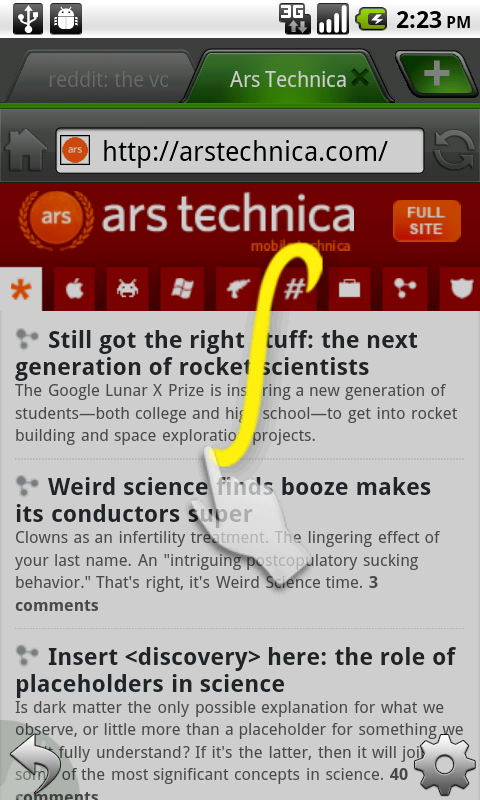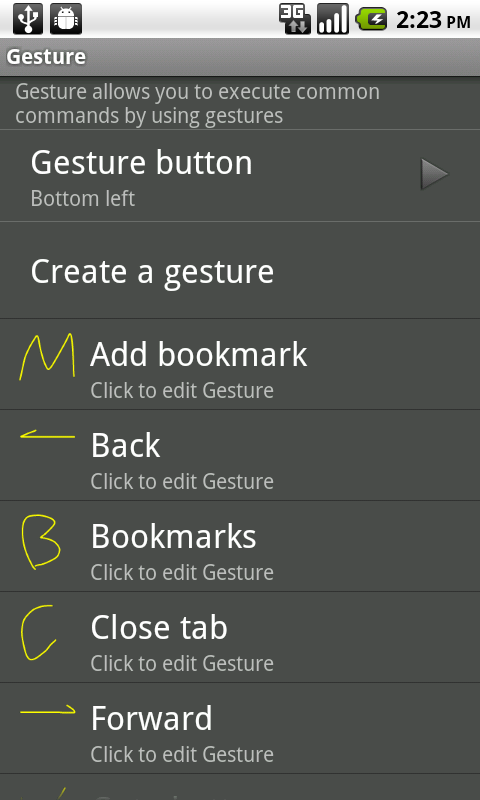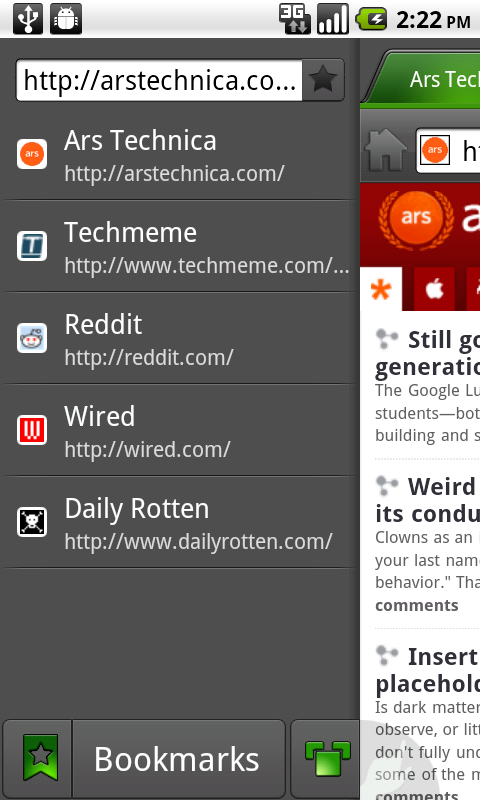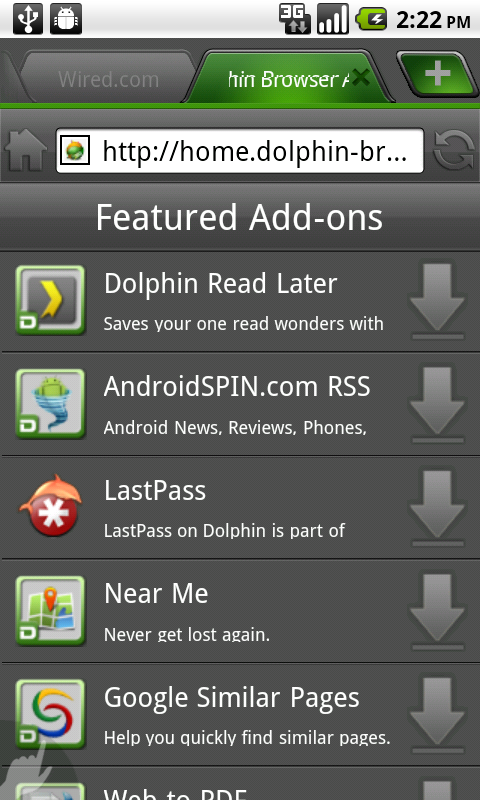One of the strengths of Google's Android mobile operating system is its support for customization. Android enthusiasts can augment the capabilities of their Android device by replacing key components of the platform with superior third-party alternatives.
There are a growing number of really great third-party home screen implementations and Web browsers that users can install directly from the Android Market. Some of the popular Web browsers include Opera, Skyfire, Firefox, and Dolphin HD. We plan to write up a full comparison at some point in the future, but decided to start by giving you a close look at our favorite: Dolphin HD.
The Dolphin browser was originally created to bring multitouch capabilities like pinch-zooming to Android prior to Google's official inclusion of that feature in the platform's standard browser. Since then, the Dolphin developers have worked to differentiate their custom browser in a multitude of ways. The current incarnation of the program—which is called Dolphin HD—offers an outstanding user interface, a sophisticated gesture command system, an add-on framework, and extensive configurability.

Dolphin HD is a WebKit-based browser that appears to use the platform's native HTML rendering component rather than its own engine. This means that it handles Web content approximately the same way as the default browser. Its distinguishing advantages all come from its user interface shell and advanced feature set.
Gestures
Dolphin HD's gesture system is well-implemented and highly configurable. To input a gesture, you first have to enter the gesture mode by tapping a translucent button in the bottom left corner of the screen. As you slide your thumb or finger over the screen to make the gesture, the software will show a yellow line that indicates the path. If the gesture is recognized, the program will perform the desired operation and then exit the gesture mode.

There are a handful of preconfigured gestures that come with the program, but you can also add your own gestures. The gesture editor lets you trace out your own gesture and assign an action to it from a list. You can use gestures for refreshing, going back and forward in the current tab history, toggling fullscreen mode, bookmarking a page, closing the current tab, opening a new tab, or practically any other standard browser action. You can also create gestures that load a specific URL. For example, I created a custom gesture that will load Ars Technica when I draw a lowercase "a" on the screen.

User interface
Much like Firefox Mobile, Dolphin HD has sidebars that are accessible when you drag the page to the right or left. The left-hand sidebar displays your bookmarks, but you can also toggle it to show your recent history or most-visited sites. In the bookmarks view, you can tap the star to bookmark the page in the active tab. The right-hand sidebar provides access to add-ons, the add-on manager, and the browser's settings panel.


One of the best features of Dolphin HD is its integrated tab bar. You can see all of your open tabs in a horizontal row at the top of the window. You can drag this row to the left or right to see additional tabs. Dolphin HD's tab bar makes tab switching and management a lot easier than it is in the platform's standard browser. The visibility of the tabs also makes it easier to remember which tabs you have open. You can close the active tab by tapping its "X" icon and you can close an inactive tab by double-tapping it.
When you scroll down the page, the navigation bar and tabs will slide off the top of the screen so that they don't detract from space for viewing content. When you are in the middle of the page, you can quickly get those user interface elements back by hitting the menu button.
Dolphin HD obviously has a lot to offer for users who want a richer user interface, but it also caters to minimalists who don't like clutter and just want the interface to get out of their way. It has an excellent full-screen mode that hides everything that's not content, including Android's notification bar. In this mode, the user can tap the menu button to make all of the standard user interface elements temporarily reappear.
Full-screen mode shines most when it is used in conjunction with the gesture commands. You can access virtually all of the tab-management features through the gesture system and avoid having to flip out of full-screen mode.
Add-ons
Dolphin HD offers a built-in add-on system that allows users to install additional functionality. The add-ons are installed via the Android Market and can be managed from within the browser by tapping the puzzle piece icon in the right-hand sidebar. There aren't a lot of add-ons available yet, but the modest assortment that is presently available fills a lot of different needs. There are add-ons for adjusting page content, backing up bookmarks, sharing a URL on a Twitter, and generating a QR code of the current page.

There are also add-ons for integrating with popular Web services such as Read It Later. I was particularly pleased to discover that LastPass offers a Dolphin HD add-on for its premium subscribers, making it possible to sync and auto-fill passwords. LastPass also has an Xmarks add-on for Dolphin HD, but it was quite limited and not as useful compared to the stand-alone Xmarks application.
Dolphin HD's add-on system appears to allow fairly robust interaction with page content and certain browser features, but it doesn't seem to allow deep customization of the user interface—that's one of the areas where Firefox still has a bit of an advantage. Most of the add-ons simply expose their features through buttons in the right-hand sidebar.
In addition to add-ons, Dolphin HD also has a simple theming system. The available themes all basically look like the standard black-and-green theme, except with a different highlighting color that replaces the green.
Settings
Dolphin HD has a comprehensive settings panel that can be accessed by clicking the gear icon in the right-hand sidebar. In addition to the standard browser settings that you would expect, it has a bunch of extras such as built-in support for user-agent spoofing, optional support for caching to the SD card instead of internal storage, a backup/restore feature, and an orientation lock. The user-agent spoofing is especially useful on larger devices like Samsung's Galaxy Tab, where you want to see the desktop version of Web sites by default.
Availability
Dolphin is available in several different flavors. The original version, which is simply called Dolphin, was built largely for Android 1.6 and is still maintained for the benefit of older devices that are running a version of Android prior to 2.0. Dolphin HD is the updated version that is intended for modern Android devices running Android 2.0 or later.
The developers recently introduced a new flavor called Dolphin Mini, which is designed for optimal performance and is also compatible with older versions of Android. Mini will eventually replace the classic Dolphin as the option for users who want a faster and lighter browsing experience or compatibility with legacy devices. Dolphin HD is currently the only variant of Dolphin that supports add-ons.
Dolphin HD is available from the Android Market at no cost. The free version has advertisements, but they are unobtrusive and rarely visible. The ad banner only seems to show up in the full bookmark manager; we haven't seen it anywhere else.
Conclusion
Dolphin HD is an outstanding browser that brings together an elegant user interface, robust feature set, good performance, and a useful add-on system. It also happens to have a much smaller disk footprint than some of the other alternative browsers because it uses the platform's standard rendering engine. After extensive testing, Dolphin HD definitely gets the nod as our favorite browser for Android. It's really great on phones and its unique advantages are even more compelling on larger devices like the Galaxy Tab.
Listing image by TriStar Pictures
reader comments
32